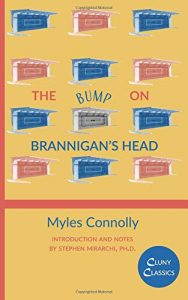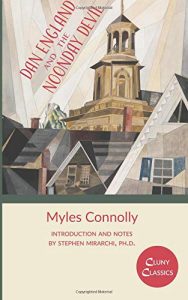
by Myles Connolly
with an introduction and notes by Stephen Mirarchi.
Cluny Media, (1950) 2018.
Paperback, 252 pages, $18.

Myles Connolly,
with an introduction and notes by Stephen Mirarchi.
Cluny Media, (1951) 2017.
Paperback, 318 pages, $18.
Reviewed by Mary Reichardt
In her delightfully acerbic manner, Flannery O’Connor often took aim at the Catholic readers who insisted that her stories were not Catholic. Her tussle with her readership, arising from her desire to be both a superb literary artist and a devout Catholic, resulted in her magnificent essays on the nature and purpose of Catholic literature collected in Mystery and Manners. More than fifty years after O’Connor’s death, the essays have lost none of their import—and their sting. Influenced by such innovative and excellent Catholic writers as Greene, Waugh, and Mauriac, O’Connor maintained that it was fully possible to be both believer and artist, for both vocations demanded eyes open to reality. “When the Catholic novelist closes his own eyes and tries to see with the eyes of the Church, the result is another addition to that large body of pious trash for which we have so long been famous,” she quipped, adding that “The Catholic reader … is so busy looking for something that fits his needs, and shows him in the best possible light, that he will find suspect anything that doesn’t serve his purposes. The word that occurs again and again in his demands for the Catholic novel is the word positive.”
While O’Connor’s wrath settled on several of her contemporary writers (Cardinal Spellman’s sorry literary attempts in particular) and while she praised others (Midwest novelist John F. Powers, for example), O’Connor does not mention Myles Connolly as far as I know. She most likely would have known about Mr. Blue, Connolly’s popular, parable-like story, written in 1928 when he was twenty-seven. Published a year before the beginning of the Great Depression, Blue provided an antidote in a time when many were driven to despair. A young man, Mr. Blue is one in a long line of American non-conformists, but his method is to embrace a radical Catholicism that takes the gospel seriously. As a modern day St. Francis, he lives free of social expectations, worldly sophistication, and security. He spends money lavishly when he has it and relishes poverty when he doesn’t. He flies kites and sleeps on New York highrise rooftops. He prays on his knees devoutly. His charms attract even skeptics such as the narrator, who grudgingly comes to see something unique and precious in Blue’s eccentricity. Blue is the rare one among us who puts the lie to Chesterton’s famous adage, “The Christian ideal has not been tried and found wanting. It has been found difficult; and left untried.” Blue tries it, and he gives his life for it.
If readers recognize Myles Connolly’s name at all these days it is most likely from Mr. Blue. However, Connolly returned to novels in the 1950s after a long hiatus. During that time, after dabbling in newspaper reporting and writing occasional short literary pieces, Connolly, aided by his friend Joseph P. Kennedy, left Boston for a screenwriting career in Hollywood at what soon became the famed RKO studio. There, as a friend of Frank Capra, he made a name for himself by helping write and produce over forty films, including contributing to It’s a Wonderful Life and Mr. Smith Goes to Washington. In the early 1950s, Connolly produced two novels: The Bump on Brannigan’s Head (1950) and Dan England and the Noonday Devil (1951). As they did several years ago with Mr. Blue, the Catholic publishing house Cluny Media has recently released new editions of these works, with an introduction and notes by Stephen Mirarchi and a brief preface by Connolly’s daughter, Mary Connolly Breiner.
The Bump on Brannigan’s Head is told with Connolly’s characteristic straightforward prose and gentle humor. We first see Tom Brannigan arguing with his adult son, Little Tom, about going to Sunday Mass. Little Tom refuses to engage a religion that, he believes, produces hypocrites like his father who despises his neighbors so unabashedly that he’s grown a hedge so he can’t see their house. But when struck in the head in an accident, Brannigan undergoes a change of heart. His temper cools and his outlook turns more compassionate. His first positive action is to cut down the hedge: “‘Love your neighbor,’ says the Church. So,’ he waved wearily out of the window toward the neighbor’s house, ‘so, I decided to give it a try.’” He endeavors to put up with irksome people and forgive those who cheat him. He doesn’t always succeed: “‘This loving your neighbor is one thing; but this loving your enemies, that’s another kettle of fish entirely. Maybe I should have left the Gospels alone’,” he sighs.
While Brannigan’s newfound charity begins to transform others, the local newspaper editor sees dollar signs in exploiting the newly minted “Saint of Whittiersville,” quickly mustering up a “We Love Everybody” Movement, complete with parade. When that ploy fails to sell newspapers, the paper just as quickly denounces Brannigan as a fraud (“You ought to have known better than to try to turn religion into news,” the editor growls at his cub reporter. “It’s gore—gore and obscenity; that’s what the readers want.”). Meanwhile Little Tom, a college educated “scientific type” who works at the Chemical Plant’s Atom Bomb Division (where “reality will surround you, will harden your mind till it is like steel, will crystallize your emotions till they are like diamonds, will stalk and destroy the Dream”) and who was never convinced about his father’s “sainthood,” has a change of heart and the two reconcile. As Mirarchi states in his introduction, the book emphasizes the difficulty of truly loving others, as the Gospels demand, yet the redemptive work of such suffering.
Dan England and the Noonday Devil is somewhat darker. Similar to Blue, Dan England employs a narrator who, conventional in the ways of the world, is initially skeptical of the eccentric ways of the protagonist and yet comes to admire him. Having tried a newspaper career, and having been in his own telling converted in an improbable manner from a conformist lifestyle, Dan England now ekes out a living as a hack writer of detective stories. His real talent and great joy, however, is gathering his motley group of friends and acquaintances nightly at his ample dinner table where he holds court. His home “was a veritable hotel” for his friends, and those friends “were parasites of the most genuine and enduring sort,” including artists, ex-fighters, derelicts, “refugees from Communism and White Supremacy,”—“all having in common a love of Dan’s hospitality and generosity and a few having a love of Dan himself.”
A romantic, an eclectic reader, a storyteller, and an ardent Catholic, Dan indulges in wide-ranging talk that includes paeans to the beauty of the Church and the heroics of the saints and the martyrs. He maintains the “belief that Scripture and the saints should be a natural part of the common small talk and banter of each and every day.” The narrator, a newspaper man, is drawn into Dan’s circle after witnessing Dan’s humanizing effect on a colleague. Betrayed by one of his hangers-on, Dan exhibits a Christ-like forgiveness despite the personal cost: “What mattered to him was not serenity or success but what he so often called ‘the plain but nonetheless terrible necessity’ of saving his soul,” the narrator muses.
True to his cinematic training, Connolly’s novels often consist of a series of brief set pieces or vignettes. His characteristic theme is that of the man who eschews a conventional, conformist way of life in pursuit of human freedom. One is reminded of Melville’s “Bartleby the Scrivener,” which similarly tells a parable-like tale of the ultimate “drop-out” from mercenary society and that also employs an initially skeptical narrator. The great difference is, of course, that Connolly’s fools are holy fools. While O’Connor’s original Catholic readers would no doubt enthuse over these novels as decidedly positive expositions of the Catholic faith, Connolly acknowledges the suffering and sacrifice that comes with such belief. This theme is of enduring spiritual value. Bump and Dan England are reminiscent of a more innocent time in the Church and in society. As a 2016 Commonweal review stated of Mr. Blue, Connolly’s works collectively form “the last earnest Catholic novel.”
Stephen Mirachi’s well-written introductions place the novels in helpful context and highlight their Catholic themes. His notes are fulsome and useful in particular for a modern audience who may not know certain elements of pre-Vatican II Catholic language and customs. My only quibble with The Bump on Brannigan’s Head is a number of distracting typos from the digitization process (ear for car; Assist for Assisi; np for up; glim for grim), some of which may well have been in the original publication but should have been corrected here. [Editor’s note: The publishers report that these typographical errors have since been corrected.]
Mary Reichardt is professor of English at the University of St. Thomas in St. Paul, Minnesota and editor of the Encyclopedia of Catholic Literature.